
Pentatomidae is a family of insects belonging to the order Hemiptera, generally called shield bugs or stink bugs. Pentatomidae is the largest family in the superfamily Pentatomoidea, and contains around 900 genera and over 4700 species. As hemipterans, the pentatomids have piercing sucking mouthparts, and most are phytophagous, including several species which are severe pests on agricultural crops. However, some species, particularly in the subfamily Asopinae, are predatory and may be considered beneficial.

Pyrrhocoridae is a family of insects with more than 300 species world-wide. Many are red coloured and are known as red bugs and some species are called cotton stainers because their feeding activities leave an indelible yellow-brownish stain on cotton crops. A common species in parts of Europe is the firebug, and its genus name Pyrrhocoris and the family name are derived from the Greek roots for fire "pyrrho-" and bug "coris". Members of this family are often confused with, but can be quickly separated from, Lygaeidae by the lack of ocelli on the top of the head.

Ranatra is a genus of slender predatory insects of the family Nepidae, known as water scorpions or water stick-insects. There are around 100 Ranatra species found in freshwater habitats around the world, both in warm and temperate regions, with the highest diversity in South America and Asia. Fewer are found elsewhere, but include several African, some in North America, three from Australia and three from the Palearctic, notably the relatively well-known European R. linearis. Since Ranatra belongs to the family Nepidae which in turn belongs to the order Hemiptera, ranatrids are considered "true bugs".

Alydidae, commonly known as broad-headed bugs, is a family of true bugs very similar to the closely related Coreidae. There are at least 60 genera and 300 species altogether. Distributed in the temperate and warmer regions of the Earth, most are tropical and subtropical animals; for example Europe has a mere 10 species, and only 2 of these occur outside the Mediterranean region.

Dindymus is Old World genus of true bugs in the family Pyrrhocoridae. Records of occurrence include Africa, but most are in SE Asia and Australia.

Leptoglossus is a genus of true bugs in the leaf-footed bug family and the tribe Anisoscelini. Species are distributed throughout the Americas, with some records in eastern & southern Asia and Europe. Several species are economic pests of agricultural crops. Like members of some other genera in the family, these bugs have leaflike dilations of the hind tibia. Several species are of economic importance, and one species, L. chilensis, has been reported to bite humans.

Sphedanolestes is a large genus of assassin bugs in the family (Reduviidae), subfamily Harpactorinae. There are more than 190 described species, which are found in southern Europe, Africa and Asia.

Rhynocoris is a genus of assassin bug, family (Reduviidae), in the subfamily Harpactorinae. Species are recorded from Asia, mainland Europe, Africa and North America.

Euagoras is a genus of assassin bugs, in the subfamily Harpactorinae. Species are found in Asia and Australia.
Hygia is a large genus of Asian bugs in the tribe Colpurini, erected by Philip Reese Uhler in 1861.

Capsus is a genus of mirid bugs belonging to the family Miridae, subfamily Mirinae.

Dysdercus suturellus is a species of true bug in the family Pyrrhocoridae, commonly known as a cotton stainer. The adult insect is slender, about 1 to 1.5 cm long, with a red thorax and dark brown wings marked with a yellow cross. It is native to the southeast of the United States, Jamaica and Puerto Rico. It is a pest of cotton crops and other plants, the adults and older nymphs feeding on the emerging bolls and the ripening seeds.

Lygaeus is a genus of seed bugs in the family Lygaeidae. There are more than 60 described species in Lygaeus.

Arhaphe is a genus of bordered plant bugs in the family Largidae. There are 26 described species in Arhaphe. The genus is one of a small number of hemipterans known to possess a sound-producing stridulitrum, in which the hind femur is rubbed against the costal margin of the forewings.

Tessaratoma is a genus of bugs in the family Tessaratomidae. There are more than 20 described species in Tessaratoma.

Riptortus is a genus of broad-headed bugs in the family Alydidae. There are more than 20 described species in Riptortus.

Physopelta is a genus of bordered plant bugs in the family Largidae. There are about 30 described species in Physopelta, found in Asia and Oceania.

Acanthocoris is the type genus of the tribe Acanthocorini, erected by Amyot and Serville in 1843. Species of these leaf-footed bugs have been recorded from Africa and Asia.

The Cloresmini, sometimes called bamboo coreids, are a tribe of leaf-footed bugs, in the subfamily Coreinae erected by Carl Stål in 1873. Genera are distributed from India, China, Indochina, Malesia through to New Guinea.



















